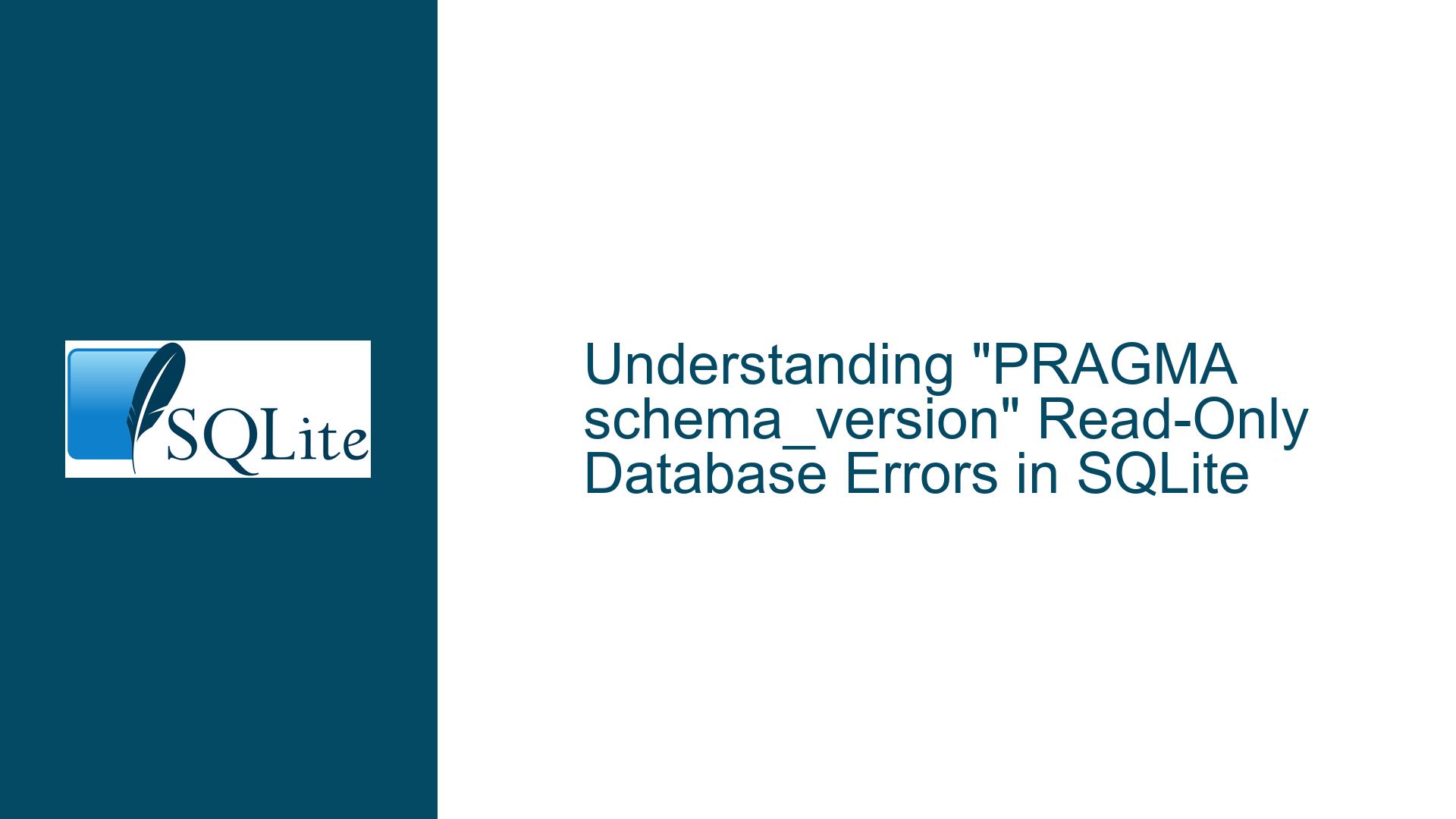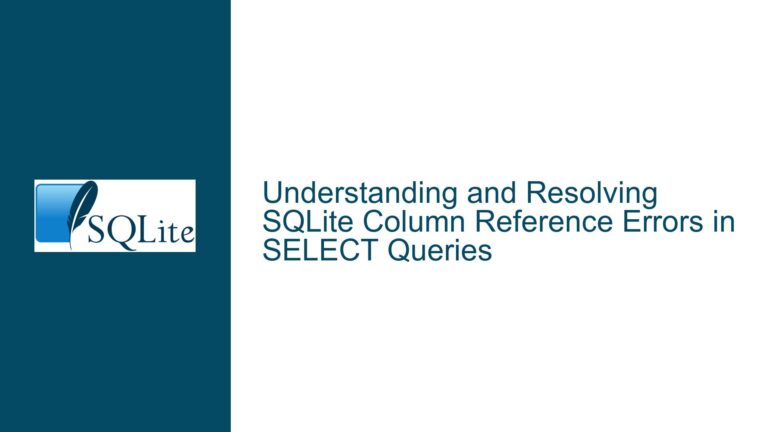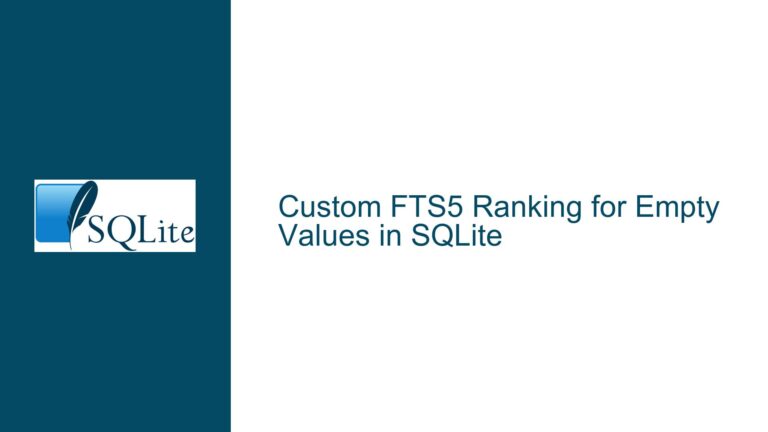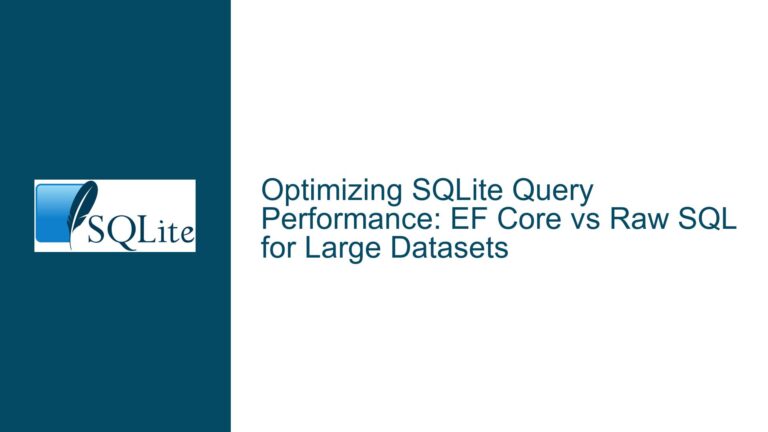“PRAGMA schema_version” Read-Only Database Errors in SQLite
Issue Overview: Read-Only Database Errors During Schema Version Checks
The error attempt to write a readonly database during execution of PRAGMA schema_version represents a conflict between SQLite’s internal mechanisms and the permissions/state of the database environment. Though PRAGMA schema_version is designed to return an integer indicating the schema version (a read operation), this error implies an unexpected write operation occurred. The contradiction arises from SQLite’s need to resolve database state inconsistencies before servicing read requests.
Three critical factors contribute to this scenario:
- Hot Journal Rollback Requirement: SQLite automatically attempts to recover from incomplete transactions by rolling back a "hot journal" (a leftover write-ahead log or rollback journal from a prior crash or abrupt disconnect). This recovery process requires write privileges, even if the immediate operation is a read.
- PRAGMA Command Dual Use: The
PRAGMA schema_versionsyntax can be used for both reading and writing (e.g.,PRAGMA schema_version = 123). Some SQLite interfaces or driver configurations may inadvertently trigger write-access checks during pragma execution, regardless of intent. - File System Permissions and Mount Configurations: The database file or its associated journal files (e.g.,
-wal,-journal) might lack write permissions for the process executing the query. Even read operations can fail if SQLite needs to modify auxiliary files to establish a consistent read state.
The error manifests in applications like Datasette when they attempt to refresh schemas by querying PRAGMA schema_version. The underlying database connection might encounter a hot journal requiring rollback, but lacks write access to the database directory or file. This creates a paradox where a read operation necessitates write capabilities.
Possible Causes: Why Read-Only Operations Trigger Write Errors
Hot Journal Recovery and Write Privilege Contention
When SQLite opens a database, it checks for the presence of a hot journal (e.g., database.sqlite-journal or database.sqlite-wal). If found, SQLite attempts to restore the database to a consistent state by replaying or discarding incomplete transactions. This recovery process is a write operation that modifies the main database file and deletes the hot journal. If the database connection lacks write permissions, this automatic recovery fails, causing errors even for subsequent read operations.
PRAGMA Syntax Ambiguity and Access Checks
The PRAGMA command in SQLite serves dual purposes: retrieving settings (PRAGMA schema_version;) and modifying them (PRAGMA schema_version = 123;). Some SQLite drivers or ORM layers perform preliminary write-access checks when encountering PRAGMA statements, assuming they might alter the database. This can lead to false positives where read-only pragmas are blocked by overly restrictive permissions checks.
File System and Journaling Mode Mismatches
SQLite’s journaling mode (e.g., DELETE, TRUNCATE, PERSIST, WAL) influences how it manages transaction logs. In WAL mode, for instance, read operations require access to the -wal file, and write operations require a -shm file. If the directory containing these files is read-only, or if the process lacks permissions to modify them, operations that should be read-only may still fail.
Mounted File Systems and Immutable Flags
Databases stored on read-only mounted volumes (e.g., Docker volumes with ro flags, CD-ROMs, or network filesystems mounted as read-only) will prevent SQLite from performing any write operations, including hot journal recovery. Similarly, immutable file attributes (e.g., chattr +i on Linux) can render the database or its journals unmodifiable.
Troubleshooting Steps, Solutions & Fixes
Step 1: Verify File System Permissions and Journal State
Check Database File and Directory Permissions:
Confirm the SQLite process has write access to the database file and its directory. Usels -l(Unix) oricacls(Windows) to inspect permissions. For example:ls -l /path/to/database.sqlite ls -ld /path/to/database_directory/Ensure the user/group executing the process has
rwpermissions on both the file and directory.Identify Hot Journals:
Look for temporary journal files in the database directory:ls -l /path/to/database.sqlite-*Files like
database.sqlite-journal(rollback journal) ordatabase.sqlite-wal(write-ahead log) indicate an incomplete transaction. If these exist, SQLite will attempt recovery on the next connection.Resolve Hot Journals Manually:
- Stop all processes accessing the database.
- If using WAL mode, execute:
sqlite3 database.sqlite 'PRAGMA wal_checkpoint;' - For rollback journals, remove the journal file only if the database is not corrupted:
rm database.sqlite-journal
Step 2: Adjust SQLite Connection Settings and PRAGMA Usage
Open Connections in Read-Only Mode When Appropriate:
Configure the application to open the database in read-only mode if writes are never intended. In Python:import sqlite3 conn = sqlite3.connect('file:database.sqlite?mode=ro', uri=True)This prevents SQLite from attempting hot journal recovery, as read-only mode skips write operations.
Use Table-Valued Functions for Schema Queries:
ReplacePRAGMA schema_versionwith thepragma_schema_versiontable-valued function to avoid write-access checks:SELECT * FROM pragma_schema_version;This syntax is unambiguous and treated as a read-only query.
Disable Automatic Schema Version Tracking:
If detecting schema changes is the goal, use alternative methods like hashing thesqlite_mastertable:import hashlib cursor.execute("SELECT group_concat(sql) FROM sqlite_master") schema_hash = hashlib.md5(cursor.fetchone()[0].encode()).hexdigest()Compare this hash across sessions to detect schema changes without querying
schema_version.
Step 3: Configure Journaling Modes and File System Mounts
Switch to WAL Journaling Mode:
WAL mode offers better concurrency and avoids some hot journal issues. Enable it with:PRAGMA journal_mode=WAL;Ensure the directory has write permissions for
-waland-shmfiles.Mount Databases on Read-Write File Systems:
Avoid storing databases on read-only media. If using containers or network mounts, verify they are mounted withrw(read-write) options.Set Immutable Flags Judiciously:
If the database must be read-only (e.g., deployed as static content), disable journaling entirely:PRAGMA journal_mode=OFF;Caution: This disables crash recovery mechanisms.
Step 4: Handle Hot Journals Programmatically
Catch and Retry Exceptions:
Implement retry logic with write access in the application. For example:import sqlite3 from time import sleep def get_schema_version(db_path): for _ in range(3): try: conn = sqlite3.connect(db_path) return conn.execute("PRAGMA schema_version").fetchone()[0] except sqlite3.OperationalError as e: if "readonly" in str(e): sleep(1) # Wait for potential concurrent recovery else: raise raise RuntimeError("Failed to read schema version after retries")Preemptively Recover Hot Journals:
Run a checkpoint before accessing the database:conn.execute("PRAGMA wal_checkpoint(FULL);")
Step 5: Audit Application and Driver Behavior
Review SQLite Driver Configuration:
Some drivers (e.g., Python’ssqlite3,aiosqlite) may implicitly open databases in read-write mode. Explicitly setmode=roin connection URIs.Inspect ORM and Framework Code:
Frameworks like Datasette might internally execute pragmas or other statements that trigger write-access checks. Override these with safer alternatives.
By systematically addressing permissions, journaling modes, and query patterns, developers can resolve the paradox of read operations triggering write errors in SQLite. The root cause often lies in SQLite’s internal recovery mechanisms conflicting with environmental constraints, necessitating a holistic approach to database configuration and access patterns.






